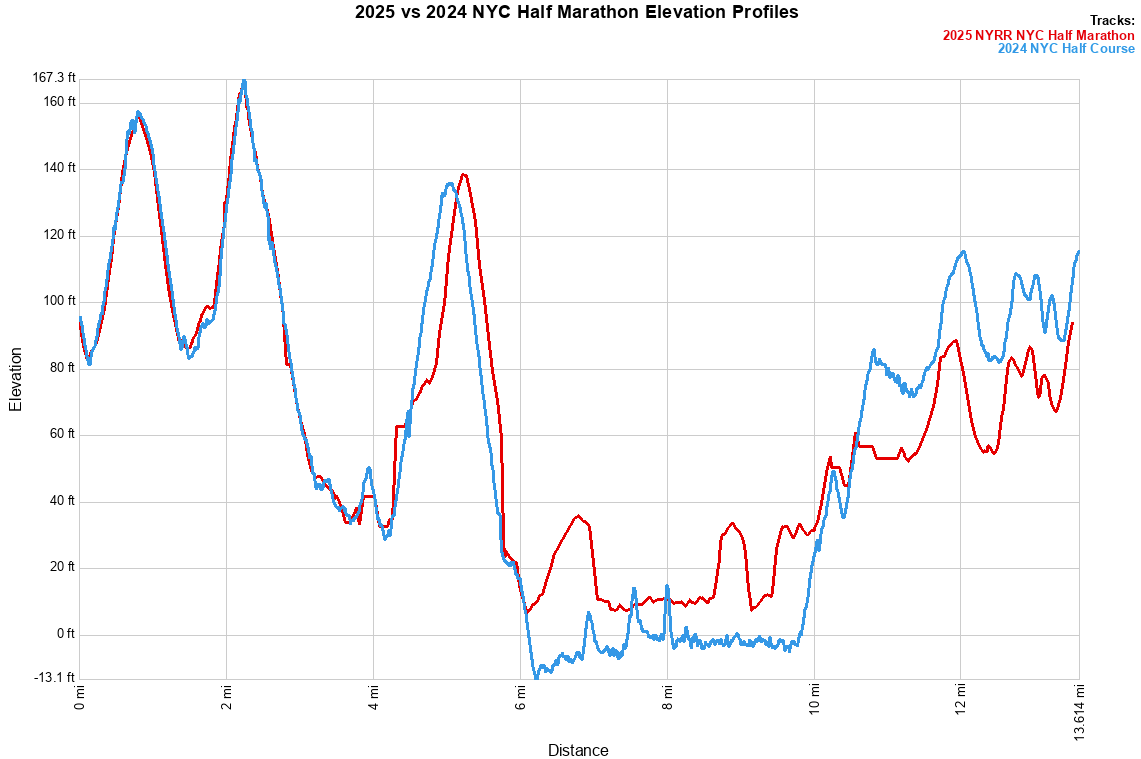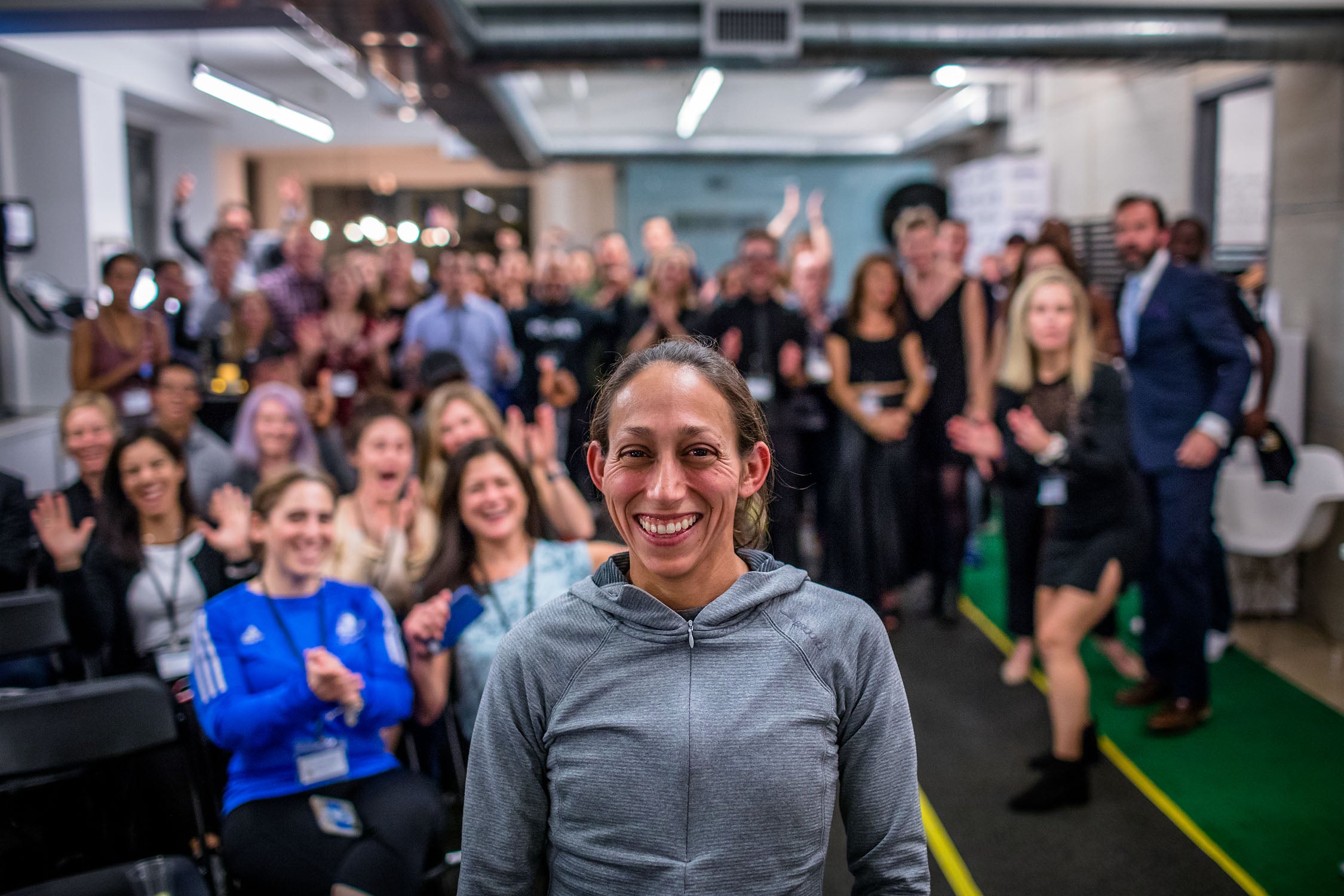Over the years, we've worked to publish what we is the gold standard review of the NYRR NYC Half Marathon course. NYRR has changed the course several times over the years and rarely do we have an unchanged year.
This year, we've seen a massive change due to the modifications required from the Manhattan Bridge construction. Usually we run the course ourselves but that's essentially impossible outside of the race given how much of it is is normally inaccessible. Our analysis compares this year's course with last year (which was largely the same for a few years). Overall, we're here to help you prepare for the big day!
While the NYRR Brooklyn Half Marathon is the clear winner of "fastest" NYRR hosted half marathon, we consistently saw runners drop serious times at the NYC Half. We don't feel the changes this year change that. It's no gimme, but you it is absolutely a course that you can have your best day at.
Let's get to work.
Here is the detailed interactive map as provided by NYRR:
And here is how the course profile tracks to last year:

In aggregate...not THAT much has changed in terms of of the profile. The red is this year's course while the blue is an actual GPS profile of the 2024 course (which explains the slight elevation difference seen toward the end), but the course maintains the same general sections. Two early hills around prospect park. A bridge. A four mile section on the FDR drive, and a 5K jaunt to get home through Times Square and a part of Central Park.
If you're looking to do well, you'll be rewarded if you strategize - particularly early on. The following analysis compares the NYC Half's current course to the original 2024 course, as well as to the recent iteration of the Fred Lebow half.
THE FIRST HALF
Getting to the Start and Corrals:
A race of this size requires planning not only for the race itself, but for getting to the start with as little stress as possible. The corral area on Washington Ave for this year's race is similar to the NYRR Brooklyn Half which loads on Eastern Parkway and starts on Washington Ave. To accommodate this, NYRR has a 5 wave system this year. Runners will wait on Washington Ave per the official start line map.
The 2025 wave starts are below as per NYRR as of 9 March 2025:

This distribution is generally considered a benefit in helping distribute runners but we have still seen and heard of runners that found themselves in pretty congested areas. No matter what, this number of runners will pose a challenge somewhere and the sad truth is that some runners will have a better experience than others. The best you can do is go with the flow and mentally prepare to roll with whatever happens.
Regardless, get there early! Portapotty lines get hella long the later you arrive and there are almost always never enough. Take note of where you can enter on race morning via Eastern Parkway. And in case is isn't clear, because some people forget:
YOU DO NOT START INSIDE THE PARK.
For subways, the 2,3 line is the best bet for most. Check this link the week of the race to see if there are any MTA issues.
Now that we've gotten through race day logistics, let's get into the actual course strategy! (Below screenshot is from NYRR United Half Page. We take no ownership over their material and are showing for informational and editorial purposes.)

Start through Mile 2.5: Flatbush Ave, Battle Pass Hill, and Back on Flatbush

As you can see, there's really no practical difference between this and last year in terms of elevation. Of course, this year, the course goes over the Brooklyn Bridge and not the Manhattan Bridge. The start line is on Washington Ave, heading South. You have two immediate turns onto Flatbush Ave. Your two hills are quite soon in the race, and your first one (with the hairpin turn) is done before you finish the first mile. As with all races of this size, stay alert at the turns, but don't worry too much about running the tangents while the field is still sorting itself out. Focus more on not getting boxed in or tripping over a barrier in the first mile and you can worry about choosing your line when the race starts to spread out.
The Flatbush Ave hill isn't bad. While the grade is noticeable, it's so early that you probably be more focused on finding space in the crowd in this first mile. The part when you turn around is flat and Flatbush is quite wide. After a downhill stretch, you have a hard right into the park. Once you get into the park, you're basically done with the turns until mile 6. But not without some work.
For these early miles of the race we recommend staying to the south side of your corral, swinging wide as you turn onto East Drive, and sticking to the right on the uphill. This positions you well if you get stuck in a crowd on East Drive and when you exit the park onto Flatbush.
As you enter Prospect Park you'll have a small incline on East Drive leading up to the main hill, commonly known as "Prospect Park Hill" or "Battle Pass Hill." The hill is between 0.3 and 0.5 miles, depending on how you delineate it and has a max grade of 6.8% and an average grade of 4.3%. While very raceable, it is one of several hills you'll face, so don't power up this thing. We'd recommend you take this easy.
Prospect Park is our home turf, so we know a thing or two about Battle Pass. The most challenging aspect is that it is fairly serpentine, and tangent running may be impossible for anyone not in the AA or A coral. Where possible, make use of both lanes, and don't assume those around you are taking the best line. If you are unfamiliar with the park, it is difficult to know when you've reached the top until you're there, but just know that the hill will end and the steepest part of the early course will soon be over.
The good news is that after completing Battle Pass Hill, your early work is done! Now it's time to settle in. When exiting the park, you'll greet Grand Army Plaza (we bet there will be official cameras around GAP, so smile!) and have a nice straight path onto Flatbush Avenue. You've got about 10.5 miles from here.
Mile 2.5–4.5: Flatbush and the Entrance to Brooklyn Bridge
Flatbush is your home for 2 miles, much of it downhill (your biggest sustained one). Use the downhill here to gain speed and really dig into a nice pace that can carry you through the next section. Mile 4 is where things change from last year to this year with a turn onto Tillary Street and head toward Brooklyn Bridge.
Mile 4.5-6: Brooklyn Bridge
You're now at the beginning of what will make this year special, scenic, and iconically New York. Of course, the usual laws of bridges and hills apply. You won't benefit as much from the downhill on the other side as the challenge you'll face getting to the top.
This will be your longest sustained climb of the race. The grade is steady, the sun will be at your back and most of the race's difficult parts will already be behind you as you reach the other side. You may face some wind, and since it doesn't usually carry people on the road, there could be some potholes so be careful! Without crowds or spectators, though, the bridge is a good chance to check in, settle into your pace and focus for the second half. The downhill side offers a good opportunity to pick up the pace a bit. Now we've driven this bit dozens of times. and we've actually wondered what it would be like to run it. But you're basically going to be on a highway ramp meant for fast moving cars so while the GPS profile looks windy, you'll be fine if cars take these turns going 60mph!
As this point, you will have finished 6 miles, the long and mostly flat FDR is ahead of your, and life should be looking good!
THE SECOND HALF

Mile 6–10: FDR Drive
Given you're taking the exit ramp from the bridge to the FDR, we can confirm that this part is undulating and those bumps are indeed what you'll experience in the race - though our experience is that these ramps are generally not noticeable certain in the context of the larger race. This nearly 4-mile stretch is otherwise mostly flat and a welcome reprieve from the serious changes in elevation you experienced earlier (and will experience again soon).
We love the FDR for its scenic views of the Manhattan and Brooklyn skylines as well as the race beacon that is the United Nations building near the end of mile 9, signaling the turn to 42nd Street. Be aware that GPS usually goes a little haywire through this stretch, so it's good to have race pace locked in and not rely too much on your watch. Enjoy the views as you'll finish this section, crossing 3rd Avenue with the our favorite NYC building, the Chrysler, just ahead.
As a final consideration on this section of the course, we will point out that you're most exposed to the elements here. The FDR is wide open with the river to your right. The sun is at your right, or your back. If it is raining, there are no buildings, trees, or overhead ramps to shield you. If there is wind, then nothing will break or divert its force. Pay close attention to the weather report and set your expectations accordingly.
While we can't tell you the weather in advance, we can tell you where the sun is going to be! The following image from www.suncalc.org shows the location of the sun at 9:00 AM on race day. If it is a clear day, the sun will be virtually unobstructed. The later you get to this point, the farther behind and above you the sun will be.

Mile 10–12: Crosstown traffic and Times Square
To is, the 10-mile mark is the most significant point in a half marathon race. You have 5K left—a mentally manageable and easily understood distance for almost any runner. It is also usually where your brain may want to swerve away from the on-ramp to the pain cave. But no! You have time to make one more move. Lean into this thing. Now's the time to remember why you put all that time into training, and what you're capable of. Game on!
For those not familiar with NYC running, do not be fooled into thinking that Manhattan is an easy pancake-flat island. The beginning of the final 5K is not a crosstown express, even though you can ignore the traffic lights (and run in the express bus lane). Instead, it starts as a gradual uphill climb which continues all the way to the finish! Take note of the elevation map. There are some ups and downs in the final stretch, and your mission is to keep yourself steady.
Please note that your watch in this section will be bugging out. No one EVER gets a clean GPS reading with skyscrapers to your right and left. Your watch might read a 17-minute pace and then a world record mile immediately after. (This is exclusively why the graphs show my run as 14.4 miles and not closer to 13.1.)
As you wonder 1) WTF just happened and 2) if the city is trying to tip you back into the East River, don't forget to look UP and around—the Chrysler, Grand Central, the New York Public Library, and Bryant Park are all around you. Keep your cool, anticipate the hills, soak in the cheer squads, and you will be fine.
When you turn right onto 7th Avenue, you will find yourself in Times Square, a magical and memorable experience--particularly when you're not trudging through it at tourist pace. Even as a local who works in Times Square, I can't help but smile in awe as the city stops, holds traffic, and carries me up to Central Park. New York runners get goosebumps just thinking about it. While this is also steadily uphill, you might not know it as the energy is positively electric.
Once you hit 59th street, you'll hang a right onto Central Park South, finishing up mile 12 and entering the park at the southeast corner—the same corner where you exit in the final stretch of the full NYC Marathon.
Mile 12 to the Finish: Take Me Home
(Screenshot taken from official NYRR documentation - we take no ownership over any of their material and are just showing it for informational purposes)

Here, you'll pass the too familiar smells of horse carriages, and extern the wonderful Central Park loop. Cross the 72nd Street Transverse and finish at the same spot as the NYC Marathon, between Sheep Meadow Park and Tavern on the Green. This last hurrah through Central Park is comparatively a pretty easy section.
While there are still minor ups and downs, particularly at Bethesda Fountain (about 400M from the finish), we think you can start your kick whenever you're ready. The only thing left will be to cross that finish line!
Photo Ops
It's difficult to know where the course photographers will be but I'm willing to bet they will have some when you exit Manhattan Bridge, in Times Square, and in Central Park. We would guess that they'll also have photographers in Grand Army Plaza. Heads up, throw a Blue Steel, Ferrari or Le Tigra and smile!
Overall Elevation Analysis
The min/max elevations of last year to this year is pretty identical. The NYC half has always been a challenging course though not the hardest (Lebow takes that crown).

All in all, we like it. Like all things in NYC, you have to work for it. The sharp turn around point on Flatbush 1 mile could be annoying depending on where you are in your corral/wave. The many other sharp turns aren't pleasant. The start has proven to be good for some but NOT for all. As with almost any NYRR race, they could do with more porta-potties.
All that said, the best we can do is prepare and take it as it comes. You're doing the work on the physical end, and we hope this post has helped on the mental end. This is definitely a course that rewards preparation and smart tactics. Some final reminders? Nothing new on race day (or, in our personal rulebooks, for 72 hours before the race). Come with A and B goals. Trust in your training. And for this course in particular? Manage your mental and physical engines.
This will be a formidable challenge. And at the end of the day, we get to run through one of the greatest cities in the world.
Good Luck!
Bakline wishes all NYC Half runners the very best in their training and on race day. Stay injury-free, and maybe get a healthy dose of hill repeats in your plan this year. A thank you to http://www.gpsvisualizer.com/ for giving us the ability to present data analysis to you.



